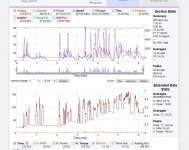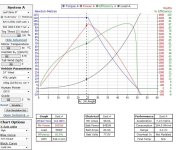No pun intended, but this thread appears to be a dog's breakfast. The concept is extremely simple, but this thread has confused me through REALLY weird expressions, like "voltage drop per 1000w".
When it boils down to it, the "voltage drop per 1000w", is nothing more than internal resistance. You can do all the maths you want behind it to convert the units, but the universally accepted one is:
DCIR=(V1-V2)/(I2-I1)
That means, as long as you know any four of the five values in that formula, you can calculate the fifth. And yes, since you have both voltage and current, if you want to convert half the equation to watts instead, you can calculate the "voltage drop per 1000w"

Since the Cycle Analyst has access to the four values on the right of the equation, it can calculate the DCIR.
As for comparing apples with apples, batteries follow Ohm's law in terms of series and parallel resistors as well, so:
1. As you put cells in series, the internal resistance of the battery will increase. This means that higher voltage batteries will drop more voltage on the same load - But only as a real number - As a percentage, it will drop the same (In a perfect resistor type situation, not real life)
2. As you put cells in parallel, the internal resistance of the battery will decrease. As an extension to point 2 - The larger capacity the cell, all else being equal, the lower the internal resistance (After all, a bigger cell is really just more smaller cells in parallel...)
Given the two above, a 100v, 1Ah battery should sag twice the number of volts, than a 50v, 2Ah battery built with the same cells. But as a percentage, they should be identical (But again, it won't be, because there are connectors, changes in temp, etc).
Anyway, in Li-Ion/LiPo:
3mOhms in a 10Ah cell would be decent, but nothing to write home about.
3mOhms in a 1Ah cell would be pretty impressive.
3mOhms in a 100Ah cell would be somewhat disappointing.
The Multistars were about that (3mOhms on a 10Ah). The Nanotechs from memory were closer to high 1s per cell. You can probably calculate your own DCIR to see how you compare.
Hope that makes any confusion clearer. Because I'm still confused about why someone would want DCIR expressed as volts per 1000W... Especially since you'd have to convert back to compare battery packs of different voltages... But anyway... Maybe I'm the crazy one and this one makes sense to everyone else.




